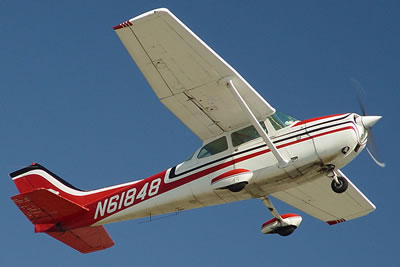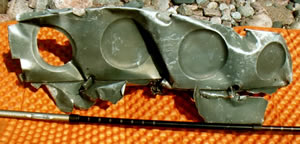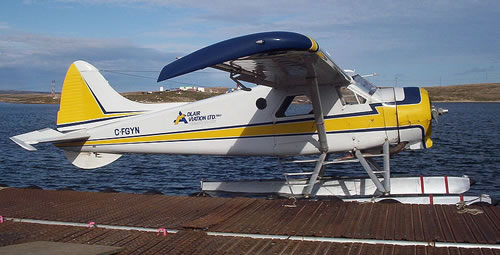
MiBSAR's home page
Bush Plane Wreck Investigation
White Gravel
Canyon
Pukaskwa National Park
Thunder Bay District
Marathon, Ontario, Canada
 |
|
|
The piece of wreckage found in White Gravel Canyon
in Canada's Pukaskwa National Park was a wing rib, probably from
a small, very old airframe, the make and model of which remains
to be determined.
|
|
|
Click
here or on photo |
|
 |
|
|
Click
here or on photo
for high-resolution imagery of wreckage. (Photo courtesy of Mary Powell) |
|
 |
|
On a 12-day expedition in August of 2005, Michael Neiger and his partners Gail Staisil, Mary Powell, Cathy Susan, and Charlie Robertson discovered a single piece of what appeared to be bush plane wreckage.
Read journal from this expedition
View slideshow from this expedition
It was found under vegetation, perched atop a high-water, rock shelf, along the western bank of the White Gravel River at noon on August 7.
This single piece of riveted aluminum measured about 29.5 inches (75 centimeters) in length and 6.9 inches (17.5 centimeters) in width.
The three photos of the wreckage include an orange Z-rest sleeping pad for background contrast and a walking stick for scale.
While the exterior was painted white, and bore remnants of what appeared to be a 3-inch-wide portion of a red number, the interior was painted with olive-drab primer. A somewhat equivocal two-line, alphanumeric identification code was stamped inside.
At first glance, it appeared to be a thin cross-section of a wing rib.
A subsequent search of the canyon riverbed proper, upstream of this piece of wreckage, only turned up one very-short piece of 1/8-inch-diameter coaxial (communications) cable on an exposed gravel bar.
While it's possible this piece of wreckage originated from a previously known wreck, one that was only partially salvaged, when expedition members reached a park ranger eight days later, he indicated no knowledge of a wreck in the White Gravel Canyon area back to the mid 1960s, when he was hired by the park.
However, several planes are known to have disappeared without a trace along the rugged, north shore of Lake Superior.
If this wing rib is in fact from an old, undiscovered wreck, as suspected, it was likely carried downstream by decades of ice-outs and spring floods from the fuselage somewhere upstream.
Since the brushy banks of the river as well as the thickly-forested hills and canyon walls surrounding were not searched in 2005, a search-and-rescue expedition back to the canyon is tentatively planned for the summer of 2010, once the piece of wreckage has been thoroughly analyzed for clues by MiBSAR and crash experts, and after records of known plane wrecks in the area as well as missing planes have been reviewed.
MiBSAR's crash investigation research log
June 29, 2010:
Seattle, Washington-area aviation experts examine wreckage for MiBSAR
A panel of aviation experts from the Seattle, Washington-area examined the wreckage photos and agreed with MiBSAR that it was definitely a rib, almost certainly from the wing of a very small plane. However, they also said it could possibly also be the rib from the horizontal stabilizer from a much larger plan.
Their analysis of the alpha-numeric markings on the inside of the rib and wing-skin assembly resulted in the following determination:
- "ALCL" refers to "ALCLAD Aluminum," an alloy widely used in metal aircraft construction;
- "QA362" is a military specification for a type of sheet or plate aluminum alloy; a very old specification, "QA362" is actually "QQ-A-362," which was superceded by "QQ-A-250/5," which has a commercial designation of Aluminum Alloy Alclad "2024."
The experts were able to eliminate deHavilland, Cesna, and Beechcraft airframes as an origin of this piece.
The shape of the wing cross-section—a narrow, nearly complete, mid-wing slice—as well as its condition led them to conclude the airframe impacted the ground in a very violent, catastrophic manner.
July 1, 2010:
Daytona Beach, Florida-area aviation safety expert examines wreckage for MiBSAR
A Daytona Beach, Florida-area aviation safety expert examined the wreckage photos and agreed it was some type of wing rib.
He said the rib as well as the inside of the wing skin was coated with a dark-green, anticorrosive paint.
The alpha-numeric markings on the inside of the wing rib were likely materials-related numbers, not part numbers.
He was able to eliminate Piper airframes as a possible source.
July 2, 2010:
Army Research Laboratory document from Aberdeen Proving Ground sheds light on mil-spec numbers on wreckage
A June 2006, report from the Army Research Laboratory at the Aberdeen Proving Ground in Maryland detailed the history of the QA362 military specification in an analysis of a cracked UH-1 Helicopter Tailboom, concluding this specification was "a very old canceled specification. No copies of that specification could be recovered."
The U.S. Army Aviation and Missile Command sent the U.S. Army Research Laboratory Weapons and Material Research Directorate a UH-1 tailboom former (P/N 201030-807-97) from the U.S. Army Kwajalein Atoll facility (USAKA) in the Marshall Islands for investigation. The component was being investigated due to the presence of cracks observed near bolt hole locations on the part. This component was quality deficiency report exhibit number M24H90327. The material utilized to manufacture the former was specified to be clad 2024-T4 aluminum alloy sheet IAW QQ-A-362. QQ-A-362 is a very old cancelled specification. No copies of that specification could be recovered. It was superseded by QQ-A-250/5B, which was subsequently cancelled, and superseded by the current specification for clad 2024-T4 aluminum sheet, SAE-AMS-QQ-A-250-5. The part was characterized through nondestructive inspection, chemical analysis, optical microscopy, scanning electron microscopy, and mechanical testing.
July 3, 2010:
Department Of Defense document may date aircraft wreckage to 1947-1963 perior
According to the Department Of Defense Index of Specifications and Standards: Numerical Canceled Listing (Appendix) Part IV, dated September 1, 2005, page 1043 seems to indicate that QQ-A361(2) was superceded by QQ-A-362 on June 10, 1947. QQ-A-362 was superceded by QQ-A-250/5B on January 1, 1963.
July 16, 2010:
Four planes missing in Wawa area as of 2008
The August 6, 2008 edition of The Sault Star (Sault Ste. Marie, Ontario) indicated Ontario Provincial Police in Wawa are aware of four missing planes in the region.
 |
|
| Introduced in 1956, the Cessna 172 Skyhawk pictured above is still in production today. Over 43,000 of these four-seat, 160-horsepower, single-engine, fixed-wing airframes have been manufactured to date. The 27-foot-long 172 has a wingspan of 36 feet, a cruising speed of 140 mph, and a range of 790 miles. | |
July 17, 2010:
Cessna 172 missing since 2005A single-engine Cessna 172 piloted by Dr. Ness Amano of Marathon, Ontario has been missing since mid-afternoon on July 24, 2005. He was reported missing by coworkers on August 2 when he failed to show up for work.
Neither Dr. Amano nor his plane have been seen or heard from since they departed the Sault Ste. Marie, Ontario airport, perhaps on a local flight, or en route to Marathon. Investigators said Amano's normal route was along Kings Highway 17, which involved 140- and 110-km legs along the eastern and northeastern shores of Lake Superior.
The Canadian Air Force, Canadian Coast Guard, and Civil Air Search and Rescue Association (CASARA) combed a 30,000-km-square area for Amano's plane without finding a trace.
Assets involved ground searchers, helicopters, planes, and boats: seven military aircraft, two CASARA aircraft with several spotters, two coast guard vessels, and two coast guard auxiliary vessels. Canadian Forces reportedly expended $692,000 during the search effort.
Dr. Amano was a single, 45-year-old dentist who practiced dentistry at the Marathon Dental Clinic in Marathon, Ontario for 20 years. An intensely-private outdoorsman, he had a camp east of Marathon. VFR-rated, he was reportedly a perfectionist, very cautious and meticulous when it came to his plane and flying.
In 2008, Tom Farnquest, the man who recovered the Edmund Fitzgerald's bell from the depths of Lake Superior, searched Batchawana Bay with a Phantom S4 ROV for Amano's plane without success.
September 1, 2010:
U.S.A.F. F-89C Scorpion missing off Pukaskwa Coast since 1953
Introduced in 1950, the F-89 Scorpion was developed by the Northrop Corporation as an interceptor for the United States Air Force. With a crew of two, it was powered by two Allison J35-A-35 afterburning turbojets. It had a maximum speed of 635 miles per hour at 10,600 feet, and could fly to nearly 50,000 feet. Its armament was variously configured of 20-mm canons, 70-mm and 127-mm aerial rockets, and 3,200-pound bombs. With a wingspan of 60 feet, it had a maximum range of nearly 1,400 miles. About 1,050 of these jet-powered night fighters were produced before the airframe was retired in 1969.
MiBSAR was tipped to another missing plane--a USAF F-89C Scorpion--that disappeared off the coast of what is now known as Pukaskwa National Park in 1953 by Jamie Yarduk of Sault Search and Rescue in Sault Ste. Marie, Ontario.
The olive drab color and mil-spec markings on the wreckage appear to be consistent with this vintage military plane.
MiBSAR's research turned up this account of the missing plane in the November 24, 1953 issue of the Capital Times (Madison, Wisconsin):
Lost Over Lake Superior
...A second Truax Field F-89C Scorpion jet plane was reported missing today with two occupants...
Occupants of the second plane, which disappeared Monday afternoon over Lake Superior, were 1st Lt. Felix E. Moncla, Jr., 27, of 12 Sherman Ter., the pilot, and 2nd Lt. Robert L. Wilson, 22, of 301 Huntington Ct. the radar observer.
Lt. Col. Henry W. Shoup, Truax base commander, said the jet interceptor involved in the second crash had taken off from Kinross Air Base near Sault Ste. Marie, Mich., Monday at 5:22 p.m. to investigate an unidentified plane over the lake. The Truax jet was at the Michigan base as a replacement for regular teams from the field sent to Yuma, Ariz. for gunnery maneuvers.
The spot of disappearance was about 70 miles northeast of Keweenan Point in Upper Michigan an 40 miles southeast of the Ontario shoreline. Air Force planes and most guard boats joined in a hunt for the missing fliers today, but snow and cold were hampering search. Shoup said he doubted if the fliers could remain alive overnight if they fell into the cold water.
Moncla, married and the father of two children is a native of Moreauville, La. Wilson, who was single, was a son of Renne Wilson of Ponca City, Okla....
The official U.S. Air Force Accident Report (sensitive portions redacted by U.S.A.F. censors) contained the following Summary or Circumstances statement regarding the missing aircraft:
SUMMARY OR CIRCUMSTANCES
F-89c, Serial No. 51-5853A, assigned to the 433rd Fighter Interceptor Squadron, Truax Field, Wisconsin, was reported missing over Lake Superior at approximately 2000 Eastern Standard Time (EST) on 23 November 1953. The aircraft was scrambled from Kinross Air Force Base, Michigan to participate in an Active Air Defense Mission. The aircraft and aircrew had not been located as of 1 January 1954.
Click here or on above image to view official U.S. Air Force overview map of SAR area. On 23 November 1953, F-89c, Serial No. 51-5853A, was scrambled by "Naples" GCI to intercept and identify an unknown aircraft flying over Lake Superior. The interceptor became airborne from Kinross Air Force Base, Michigan, at 1822 EST. Original radar control of the aircraft was maintained by "Naples" GCI and at 1841 EST control was transferred to "Pillow" GCI. The aircraft was flying at 30,000 feet at this time, At 1847 EST, at the request of "Pillow", the aircraft descended to 7,000 feet to begin the interception. Location of the aircraft was then approximately 150 miles northeast from Kinross AFB and over northern Lake Superior. At 1851 EST, the interceptor pilot was requested to turn to a heading of 20 degrees to the cut-off vector. After the turn was completed, the pilot was advised the unidentified aircraft was at 11 o'clock, 10 miles distant. Radar returns from both aircraft were then seen to merge on "Pillow's" radar scope. The radar return from the other aircraft indicated it was continuing on its original flight path, while the return from the F-89 disappeared from the GCI station's radar scope.
Click here or on above image to view official U.S. Air Force SAR map. The unknown aircraft being intercepted was a Royal Canadian Air Force Dakota (C-47), Serial No. VC-912, flying from Winnipeg to Sudbury, Canada. At the time of interception, it was crossing Northern lake Superior from west to east at 7,000 feet.
The pilot and radar observer were assigned to the 433rd Fighter-interceptor Squadron, Truax AFB, Wisconsin. They were on temporary duty at Kinross AFB, Michigan, while the base's regularly assigned personnel were firing gunnery at Yuma, Arizona. The pilot had a total of 811:00 hours of which 121:40 hours were in F-89 type aircraft. He had 101:00 instrument hours and 91:50 hours night time. The radar observer had a total of 206:45 hours of which 11:30 hours were at night.
Search for the missing aircraft was conducted by both USAF and RCAF aircraft without success. Although 80 per cent area coverage was reported, heavy snows precluded effective land search. All civilian reports of seeing or hearing the aircraft were investigated with negative results....read more from this official report (sensitive portions redacted by U.S.A.F. censors).
The circumstances surrounding the disappearance of this military plane are in dispute according to some UFO types: 1, 2, 3.
September 13, 2010:
Wreckage may be from an early-1960s wreck?
Introduced in 1948, a DCH-2 Beaver similar to the one pictured above reportedly crashed in White Gravel Canyon in the early 1960s. Discontinued in 1967, over 1,650 of these airframes were built by de Havilland Canada.
With a six-person capacity, a wingspan of 48 feet, and a maximum speed of 158 miles per hour, a Beaver could reach altitudes of 18,000 feet. Powered by a 450 horsepower Pratt & Whitney R-985 Wasp Jr. radial engine, it had a range of 455 miles.
MiBSAR was notified by Pukaskwa National Park personnel that a De Havilland Beaver may have crashed in White Gravel Canyon in early-60s.
No loss of life was involved.
The airframe was reportedly salvaged by White River Air.
Research on this case continues as a panel of De Havilland experts commissioned by MiBSAR ruled the wreckage in question on this case did not orignate from a De Havilland airframe.
The wreckage pends analysis by military aviation experts familiar with F-89 Scorpion airframes as the markings and subdued-green primer coat are consistent with this era plane, and one remains missing off the coast of Pukaskwa.






